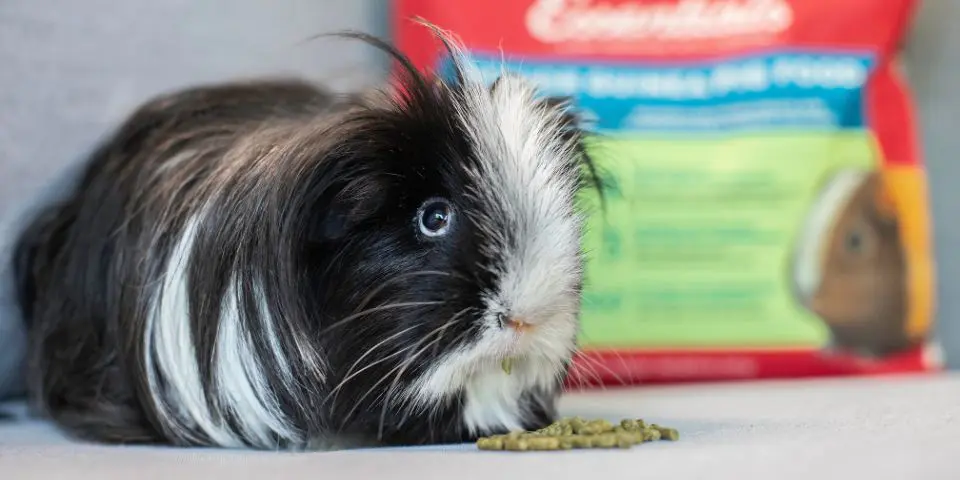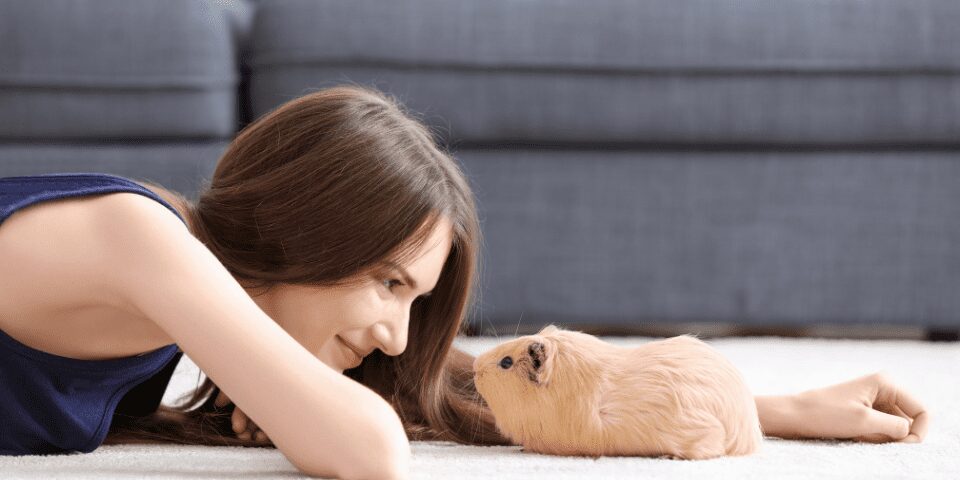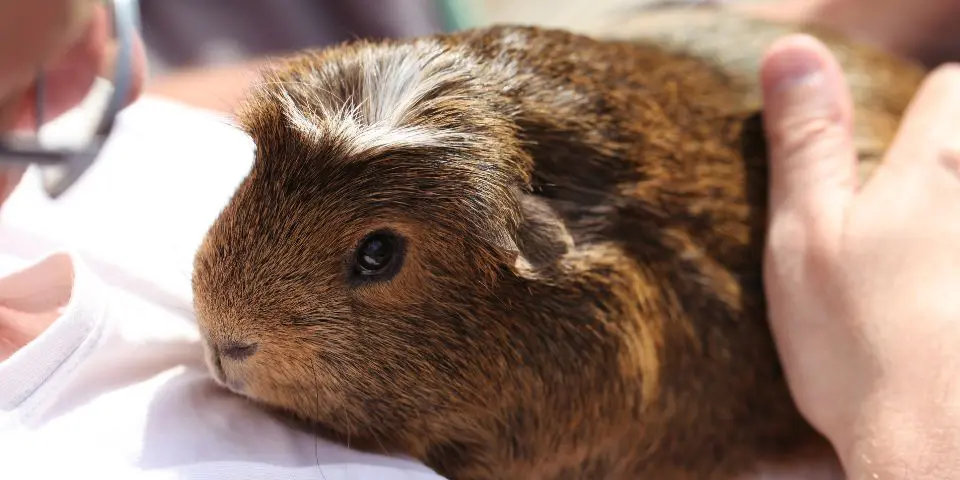Author: Kellie Hayden
Updated: March 4, 2024
Whether your guinea pig is very young and has never eaten fortified food before, or if your senior guinea pig is suddenly refusing to eat their fortified food but will eat everything else, ensuring that your pet eats their daily allotment of pellets is vital to keeping them healthy. Fortified food contains many vitamins and minerals that are essential to ensuring your pet’s daily nutritional requirements are being met.
Why Your Guinea Pig Isn’t Eating Pellets: Starting With The Basics
There could be many reasons why your guinea pig is refusing their uniform food related to normal changes in appetite and personal taste preferences, but consider the following:
Is your pet behaving and eating normally otherwise?
If your pet is acting lethargic, is not urinating or producing normal fecal matter, or is refusing hay, treats, and veggies in addition to refusing fortified food, your pet should be seen by an exotics veterinarian immediately. As prey species, small mammals naturally mask illness to avoid being an easy target for predators. This instinct remains even though your pet lives in the comfort of your home, which means they can appear healthy until they’re so sick that they can no longer mask their illness. GI stasis is a very serious illness that is often the result of another underlying health issue. It can be deadly if not treated in a timely manner.
Are you offering a uniform and nutritionally complete fortified food, or a muesli mix?
If your pet is eating a muesli mix filled with seeds, fruits, or nuts, or a type of food that is not species or age-appropriate, we highly recommend changing their food by slowly transitioning diets.
If you are feeding your guinea pig a muesli mix, you may have noticed that your little one eats the tastier parts of the mix first (such as the seeds), and leaves the pellets for last. They even may not eat the pellets at all. This behavior is called selective feeding, and it can lead to serious nutritional imbalances over time when muesli mixes are fed. When your pet leaves pellets behind, they are leaving important daily vitamins and minerals in the bowl!
You can learn more about selective feeding the importance of species and age-appropriate foods through our All About Fortified Foods information sheet.
 Have you recently changed your pet’s fortified food?
Have you recently changed your pet’s fortified food?
Sudden changes to your pet’s diet can sometimes lead to refusal, which can result in serious gastrointestinal issues if not remediated quickly. Small animals are prey species and may refuse to eat food if they detect changes in smell or taste that seem suspicious. This means that sometimes our little ones will readily eat pellets from one bag, but will turn their nose up at the same type of pellets from another bag.
Refusal can be compounded if your pet has always been a particularly picky eater. Refusal can commonly occur during the following situations:
- When a pet parent offers a different brand than what the pet is used to
- When a pet parent offers a different product line (such as moving from Oxbow Essentials to Oxbow Garden Select)
- When a pet parent offers a different life stage diet (such as moving from Essentials Adult Guinea Pig food to Essentials Senior Guinea Pig food)
- When finishing a bag of food and starting a new bag of food within the same product line
Due to all of these potential reasons why your pet could refuse to eat their pellets, we always recommend that pet parents transition their pet gradually from one bag of fortified food to another.
How To Get Your Guinea Pig to Eat Pellets
Changing your guinea pig’s eating habits can take time and patience! The following tips can help speed up the process of teaching your pet to accept their fortified food more readily if the scenarios listed above do not apply to your pet:
- Remove your pet’s food bowl for an hour or two
- Offer a few pellets in place of a treat
- Show excitement when offering your guinea pig his food
- Make a food schedule and stick to it
- Try scatter feeding
Remove your guinea pig’s food bowl for an hour or two.
We’re all familiar with the phrase “absence makes the heart grow fonder.” Sometimes with our piggies this is especially true with pellets! If you leave your pet’s food bowl in their habitat at all times, remove the food bowl from their enclosure (just make sure they have unlimited amounts of grass hay). Offer the bowl with pellets in it a few hours later to see if their interest in the food has changed. By treating the presence of the pellet bowl as a special occasion rather than part of the scenery, you may be able to convince your guinea pig that pellets are a hot commodity.
If you have let the fortified food from yesterday sit in the bowl and it has not been eaten, dispose of the old pellets and offer fresh ones from the packaging. The aroma of the new pellets may entice your little one.
It may also help to change where you’re placing the pellet bowl within the habitat. For example, if you’re placing the bowl far away from your pet’s hiding spot, place it closer to their hideout. Hideouts are where small pets tend to feel safest, and leaving this comfortable area to eat can pose a danger (according to your guinea pig’s hard-wired prey instincts).
Some guinea pigs may prefer their pellets to be near their water bottle so they can take water breaks while they’re eating their fortified food.
Offer a few pellets in place of a treat.
Measure out your pet’s fortified food beforehand and take 5-6 pellets from this allotment. Hand-feed the pellets to your pet while interacting with them, such as during couch time or while teaching them a new trick. Acting like your pet’s pellets are a reward can help convince your guinea pig to think their pellets are a treat, ensuring later on that they eat their uniform fortified food every day.

Use your “excited voice” when giving your pet fortified food.
If you already use an excited or reassuring tone of voice while praising your small pet, using that same voice can be an effective method to help get your piggy excited for their fortified food. As many pet parents know, small herbivores can heavily rely on audio cues to help predict when food is on the way (think of how some guinea pigs lose their minds when the fridge opens!). Some pet parents have developed a specific phrase that their pets recognize to mean “it’s time to eat” that also helps their pets anticipate delicious food. Since small animals quickly learn that bag crinkling, a fridge door opening, or a specific phrase can signal that food is on the way, this behavior can be used to change your small pet’s perception about how exciting uniform pelleted food can be.
Make a food schedule and stick to it.
Guinea pigs are highly scheduled animals. Offering pellets at the same time every day may help your pet anticipate when food will be provided, and by extension might help them become more interested in pellets over time. You might even find that your guinea pig will get very excited (or become very demanding) at the approximate time of day that you feed them pellets!
Try scatter feeding.
Scatter feeding can be a method that makes food fun to seek out (and eat!) for small pets because it turns food into a game. Keep in mind, some scatter feeding options might be a little too difficult for pets not wanting their pelleted food and may pose too much of a challenge if your pet isn’t interested in the reward. Easier scatter feeding options, like spreading pellets out on the clean floor of your pet’s habitat, can make food extra fun while not posing a challenge so difficult that your little one loses interest.
Other Options to Make Pellets Interesting
Restructuring how your guinea pig perceives their uniform fortified food can help keep your pet from refusing their food long after they’ve gone through the learning process. However, reconditioning small animals does not happen overnight. It will likely take time, and during that time that your pet may still have a tepid-at-best interest in their fortified food. While you are working to alter the long-term behavior and perception of your pet, here are a few methods that might help in combination with the methods above:
- Make a Salad with Pellet Croutons
- Try a Diluted Apple Juice Spritz
- Use Critical Care Powder
Make a Salad with Pellet Croutons
Try mixing your piggy’s favorite greens and veggies with their pellets in order to make a small salad! We recommend that pet parents shred the greens into smaller pieces first, making it easier to mix the pellets in. Unless a vet recommends it, do not withhold greens in hopes that they will eat their fortified food instead. Greens are an essential part of your pet’s daily diet and help keep your little one hydrated, in addition to providing vitamins and minerals that your pet is missing out on by not eating their pellets.
Try a Diluted Apple Juice Spritz
Dilute a bit of organic apple juice with drinking water and use a spray bottle to lightly spritz the diluted solution onto a daily allotment of your pet’s pellets. The pellets should be thinly spread on a clean plate or cookie sheet first. After you have sprayed the pellets once or twice with the solution, allow the pellets to dry, then serve them to your pet. The small amount of solution can help bring out the hay aroma of your guinea pig’s fortified food, and can also add a bit of sweetness to the pellets.
It’s very important to not give your pet any non-diluted apple juice, as the high amount of sugar can upset their stomach. We recommend a dilute solution of 1 part apple juice, 3 parts drinking water. After 8 hours, dispose of the spritzed pellets. If you decide to keep the solution in the spray bottle rather than mixing a new solution each time, store the solution in the refrigerator. Make sure to avoid juices that have added sugars, as these are not healthy options for your pet.
Use Critical Care Powder
Sprinkle a small amount of dry Critical Care Herbivore onto the pellets, mixing the powder throughout the bowl. Offering uniform food in this way can make the pellets more interesting to your guinea pig, especially if they already love the different flavor offerings of Critical Care. Critical Care Herbivore is currently offered in Anise, Apple-Banana, and Papaya flavors.
If you use any of the three methods mentioned above, you need to slowly transition your pet away from the method you chose once they do start eating their pellets again. Suddenly ending these methods of presenting pellets might cause your pet to go back to refusing their fortified food, meaning you’ll have to start this process all over.
If the methods above are attempted and fail to help, it’s worth exploring the possibility of offering a different line of pellets to your little one. Since some pets are especially discerning individuals, Oxbow has two fortified food lines for young guinea pigs, three pellet lines for adult guinea pigs, and had recently released a senior guinea pig food.
All of Oxbow’s food is nutritionally complete; one line is not “better” than another, and all of our foods meet the nutritional needs for the life stage and species for which they were intended. Our different lines are available to give pet parents options that align with their personal values, as well as to provide different flavor profiles that appeal to small animals’ individual taste preferences. Here’s A Side-By-Side Look at Oxbow Fortified Foods.
 When to Go to the Veterinarian
When to Go to the Veterinarian
If your pet has not eaten pellets in several days it is likely time to schedule a vet visit (please note: if your guinea pig has eaten little to nothing for 12 hours and also refuses to eat hay or greens, this is an emergency that needs veterinary care). While refusal can sometimes be chalked up to taste preferences or pickiness, fortified food refusal can also signal underlying health issues that can quickly snowball if unaddressed. Two health issues to consider are overgrown molars or gas and GI upset.
Your exotics veterinarian may also provide additional resources and advice to make sure your guinea pig is getting enough vitamins and minerals. It’s likely they have encountered other piggies not eating their pellets before and may have some additional tricks up their sleeve, or may be able to offer alternatives to fortified food.
